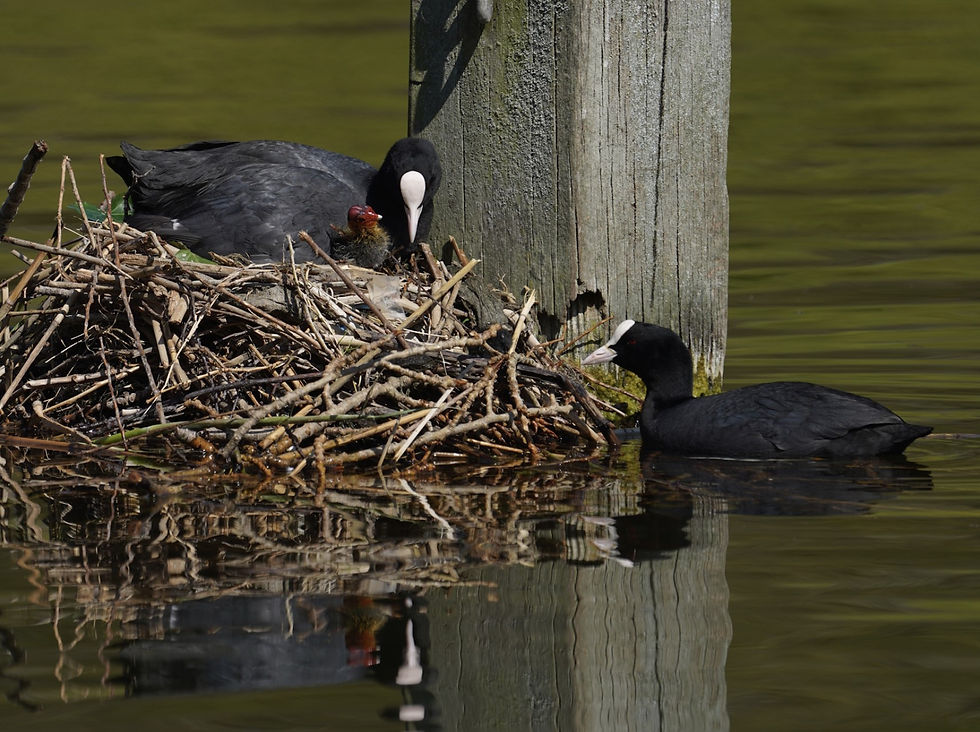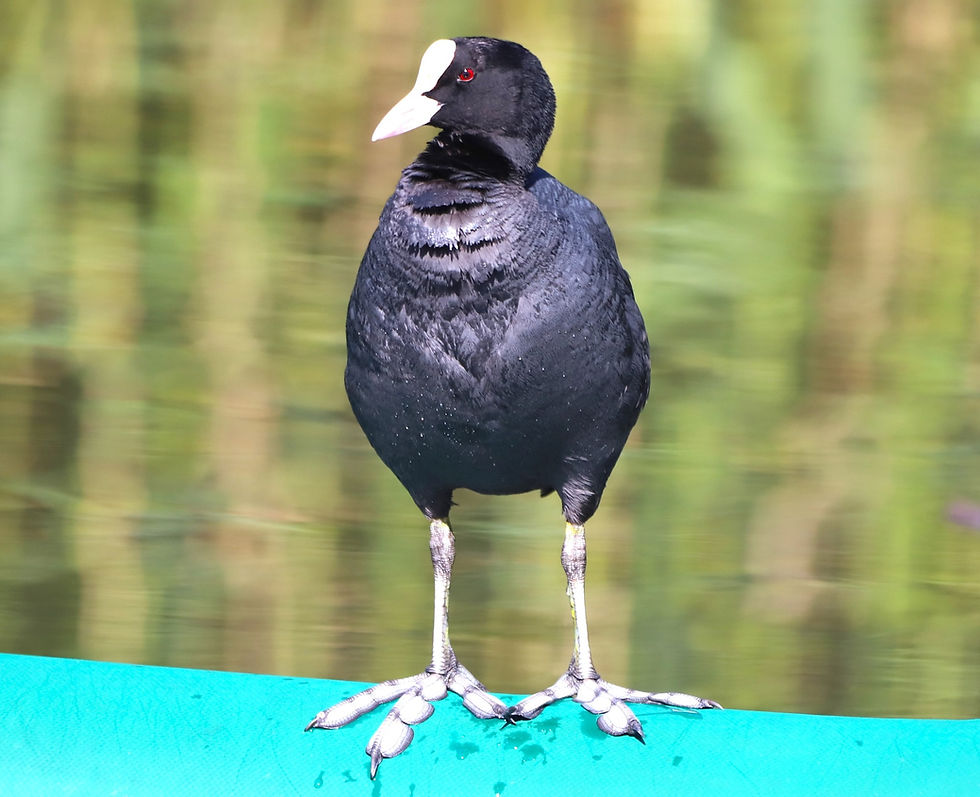Bird in the Spotlight: Eurasian Coot
- IBCP

- Sep 22
- 4 min read
22 September, 2025
By David Goodman

Eurasian Coot parent feeding chicks in Sweden. Photo credit: Nico Arcilla
A dark, plump waterbird with a distinctive white facial shield, the Eurasian Coot (Fulica atra) is the raucous, gregarious member of the otherwise secretive rail (Rallidae) family. Where most rails spend their time deep under cover in the reeds or bulrushes, coots squabble and dabble in the middle of urban lakes and reservoirs for all to see. In winter especially, they can form rafts of hundreds or thousands of birds, foraging and vocalizing noisily. They are difficult birds to miss.

Many rails require good fieldcraft and years of patience to actually lay eyes on. The Eurasian coot is not one of those. Photo credit: Alexis Lours
The coot’s white facial shield is vascularized, keratinized tissue, capable of growing and healing. It is a classic example of what is called an “honest” signal in animal communication, a sign given by individuals that would be difficult or impossible to fake. In this case, high-quality males are touting their relative fitness by having the largest, whitest facial shields. Males thus endowed have the easiest time in male hierarchy and the most success finding high-quality mates.

Look at this VERY high-quality male spotted in London’s Kensington Park that I found on the blog becomingjessi.com. This is what peak facial-shield looks like. Try to control yourselves.
Coots’ other notable adaptation is their oversized toes, which have massive, hinged, flanges and are roughly the size of regulation paddleboards. Unlike the webbed feet of ducks and geese, “lobed” toes each have broad lateral lobes that expand during the paddle stroke and fold on the recovery stroke when a coot is swimming. This is actually a relatively common adaptation among waterbirds; it appears to have evolved independently in grebes and phalaropes. Evolution loves a good idea, even if it is a little funny looking.

The craziest kicks in the animal kingdom???? Image credit: Shyamal/ Wikimedia
Despite their kind and slightly comical appearance, coots are famously territorial. Early English sources discussion the coot are a little confused about this tension. Some claim that the coot is a bird full of “wonderfull affection and love of kinde.” One medieval bestiary in Oxford’s Bodleian insists that coots sometimes foster eagle chicks and raise them as waterbirds, though I can find no other reports to corroborate this highly likely and entirely reasonable claim. Modern sources, however, tend to describe the coot as “bald,” “aggressive,” and “pugnacious.” The coot’s fall from grace since the medieval period is a stark reminder that the mob is a fickle friend.

The medieval Bodleian source’s folio of a coot, which truly looks nothing like a coot. One wonders if the artist had actually ever seen a coot. Embarrassing.
Coots construct floating, cup-shaped nests out of reeds and dead vegetation, often anchored to emergent vegetation or shrubs just above the waterline. They typically form monogamous pairs and often reuse the same mate each year. Coot chicks, which have the striking coloration of a black body with orange- or yellow-tipped down, are semi-precocious. They often leave the nest within a day of hatching, though they continue to be fed by their parents.

What I imagine a phoenix chick would look like. Photo credit: Bruce E. Lyon
Coots are highly intolerant of competition around their nests, and aggressively defend their territory from any interlopers. This intolerance extends to competition within the nest as well: when resources are scarce, coots will sometimes peck their weakest chick to death in a brutal form of brood reduction. Resource scarcity will also sometimes prompt the adult breeding pair to divide a large brood into two smaller broods, one guarded by each parent. Sometimes “extra” eggs are laid in a neighbor’s nest — a form of intraspecific brood parasitism.

INTRUDER ALERT! A coot nest with two parasitic eggs from a rival pair. Photo credit: Shizuka Lab
Eurasian coots have an extremely broad range, spanning from Europe to China to Australia. Populations in temperate areas are largely sedentary, but northern populations will migrate south for winter if lakes freeze. The Eurasian Coot is a close relative of the American coot, to which it is extremely similar. In fact, depending on your position in the perennial splitting vs. lumping debate, you may even be inclined to assert they’re the same species. I am largely agnostic on the issue, and tend to side with whichever camp has made its case to me most recently. So instead of opening the debate, I will just do this: below are photos of the Eurasian Coot (its own species), the American Coot (its own species), and the Australian Coot (considered a subspecies of the Eurasian Coot). You can wax poetic about genotypes all day, but these photos personally make me sympathize with the lumpers.



A pug and a great dane are considered the same species, but these birds are not. Photo credits: Daniel Irons, Zebedee Muller, and Kuzey Cem Kulaçoğlu
Coots generally are one of the winners of the Anthropocene. Much like American Robins in North America, or Great Thrushes in South American, or Rock Doves anywhere with a population over 500, Coots thrive off of human disturbance. Urban ponds and eutrophic lakes are just as comfortable for coots as pristine wilderness, perhaps even more so, since much of their usual competitor species cannot survive under such conditions. As such, global Eurasian Coot populations are generally stable or increasing. They are listed as Least Concern by the IUCN, although they are of great interest to many of us. We are fortunate that we have such a social member of an otherwise secretive family of birds to keep us company!

A pair of coots nesting in London’s Kensington Park. Photo credit: Ralph Hancock

A coot stands the edge of Trehörningen Lake, near Stockholm. Photo credit: Nico Arcilla




Comments